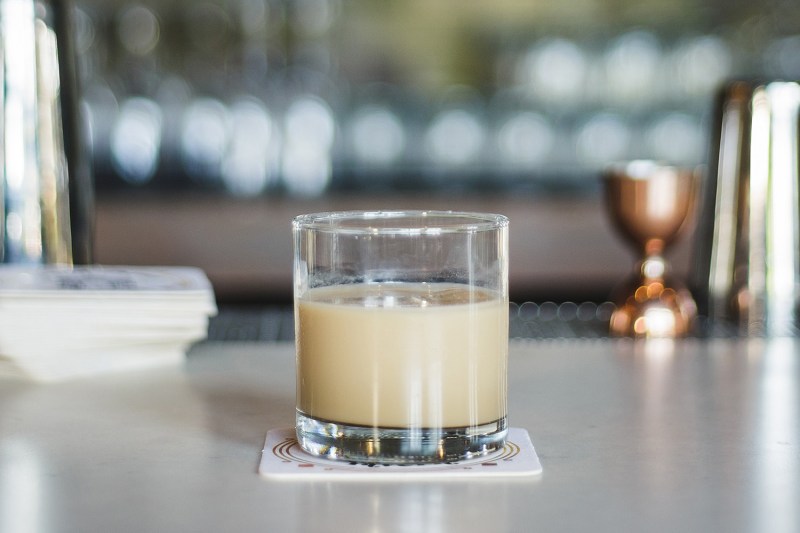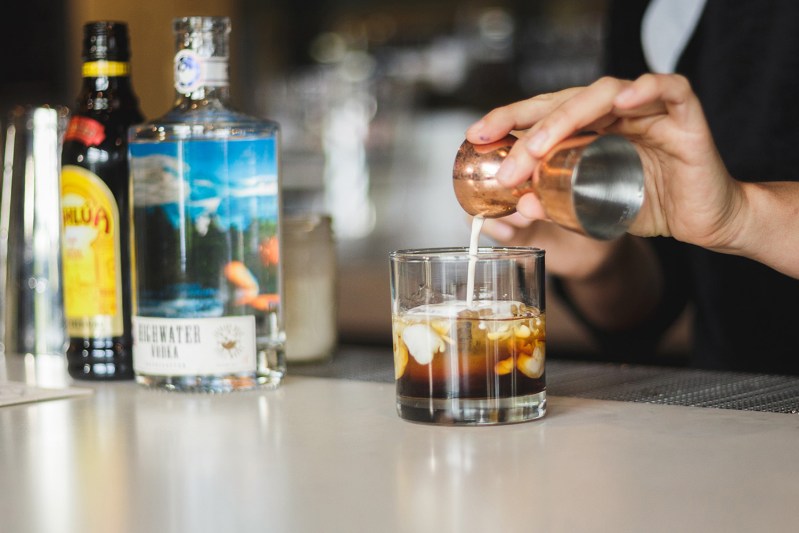“Retro” cocktails are having an undeniable moment right now, as evidenced by the current resurgence of tiki cocktails, the industry-wide interest in frozen libations, and a proliferation of artisanal spins on long-standing menu classics like boilermakers and highballs.
If a drink can claim a history dating back several decades, then there’s a good chance that it’s already experiencing a rebirth nowadays. And if the cocktail also involves a pop culture hook, the likelihood only increases. We’ve seen the comeback of the Old Fashioned, a new wave of love for James Bond’s shaken-not-stirred gin martini … even Carrie Bradshaw’s much-maligned Cosmopolitan now finds itself returning to trendy bar menus throughout the U.S.

But one cocktail with major pop culture cache is still waiting for today’s cocktail world to welcome it back with open arms: the ‘80s and ‘90s favorite known as the White Russian. This sweet, luxurious vodka beverage only requires three ingredients, and its inherent simplicity makes it a prime candidate for creative twists and craft-spirit upgrades. We chatted with a group of bartenders with soft spots for the White Russian to hear their thoughts on why this vintage sipper is due for a renaissance and to gather some inventive White Russian recipes easy enough to make at home.
What is a White Russian?
The fundamental formula for a White Russian includes vodka, coffee liqueur, and a hearty splash of heavy cream, poured over ice and stirred. The liqueur (historically, Kahlua) delivers sweetness, the cream enriches the texture, and the vodka serves as a neutral spirit base, resulting in a cocktail that’s easy to enjoy, even for those who don’t like to taste the alcohol in their mixed drinks. For that reason, the White Russian is often dismissed as a “beginner’s cocktail”, much to the chagrin of bar director Ricardo Alvarado of Black Bull and Bordel in Chicago: “White Russians have a tainted reputation because they’re what you start off drinking. It’s [considered[ a college drink for frat parties, and [it often] isn’t made right. As an adult, I realized it’s [actually] a much more sophisticated, delicate drink.”
Need more reasons to give this old-school cocktail a try? Our bartender panel has plenty to offer you.
The classic appeal of the White Russian goes beyond its starring role in The Big Lebowski.
For many people, the White Russian is most famous for its status as The Dude’s favorite drink in the Coen Brothers’ cult classic The Big Lebowski The cocktail’s popularity spiked in the late 90s after the film’s release (and waned soon after), but now that we’re more than 20 years past The Big Lebowski’s premiere, it’s high time for the White Russian to develop its own reputation, totally separate from images of a long-haired, bearded Jeff Bridges in a bathrobe.
“The glory of simple three-ingredient cocktails is that they are a canvas for creativity and experimentation, so there will always be a fresh take.”
“I don’t think that classics like the White Russian ever really go out of style. There will be ebbs and flows in popularity, but we [now] have a whole generation of bar guests who didn’t experience the [post] Big Lebowski White Russian craze, so it’s due for a resurgence. There are people of drinking age who weren’t even alive when the movie came out. The glory of simple three-ingredient cocktails is that they are a canvas for creativity and experimentation, so there will always be a fresh take,” insists bar manager Lillian Dromgoole of Bukowski Tavern in Cambridge, Massachusetts.
White Russians offer ample opportunities for creativity.
As Dromgoole mentions, the White Russian offers ample opportunities for customization, and imaginative bartenders can tweak ingredients and methods to their hearts’ content. Director of bars Will Benedetto of IGC Hospitality in New York City fully agrees, adding that “the White Russian was never a bad drink! There is nothing wrong with the original, but there is a lot of room for innovation. Coffee shops across the country use a number of dairy-alternative milks, there have never been more quality spirits available to bartenders, and there is so much innovation in the coffee world with new techniques for pulling espresso or making cold brew. There are so many ways you can combine spirits, coffee, and milk. The possibilities are endless!”
Heavy cream isn’t the only option for achieving a perfect White Russian texture and flavor.
White Russian detractors often point to the cocktail’s use of heavy cream as a negative trait, lamenting the ingredient’s high fat content. However, bartenders making White Russians in 2020 have numerous options at their disposals, allowing them to lighten up their beverages without compromising on quality.

Beverage director Alexandra Dupuis of Death or Glory in Delray Beach, Florida likes to stick with heavy cream when making her spin on the White Russian, but she adds white chocolate and Demerara sugar to the cream base, resulting in a flavorful blend that layers nicely with the cocktail’s other ingredients. “The one turn off I’ve heard from customers is the amount of cream used in the drink,” Dupuis says of the White Russian, and her housemade cream mixture can bring the desired richness and silkiness with a smaller amount than plain heavy whipping cream.
If you want to avoid dairy altogether, chief mixologist Jesse Cortez of Graybeard Distillery in Durham, North Carolina happily vouches for plant-based “milks” as valuable additions to White Russians — with a small caveat. “If you’re not a fan of heavy cream, feel free to swap in a dairy alternative like oat milk, but keep in mind that you might lose some of that velvety goodness,” Cortez tells us.
White Russians make excellent brunch cocktails
White Russians frequently fall into the category of “dessert cocktails” in the popular imagination, but the combo of coffee and spirits also makes this drink an ideal hair-of-the-dog pick for a weekend brunch. In this age of third-wave coffee shops, a libation that largely relies on java-flavored liqueur seems like a natural day-drinking fit, according to Cortez: “Honestly, I’m surprised we haven’t seen the White Russian gain popularity faster, [considering] how crazy everyone is about lattes, Frappuccinos, and whatever the crazy kids are coming up with at Starbucks these days. Besides the nationwide dependency on fancy coffee, the great thing about the White Russian is that it offers an easy, fun template to play around with behind the bar and at home.”
Bar manager Justin Greenwood of 619 Spirits Distillery and Tasting Room in San Diego thinks of the White Russian as a welcome alternative to popular brunch cocktails like the mimosa or the Bellini, telling us that “White Russians are the underrated cocktail of the brunch society, and are a great substitute for those that are not a fan of the bubbly and need a little pick-me-up in the morning.”
White Russian Recipes
Vegan White Russian
(Created by Cera Fairhurst, Beverage Manager, Aqimero at the Ritz-Carlton, Philadelphia)
“White Russians are one of those classic cocktails that you can have a happy hour, at your local watering hole, or as a nightcap in your living room. I had developed my own recipe that is vegan, super-simple and super-delicious,” says Cera Fairhurst of her non-dairy version of this beverage staple.
- 2.5 oz peanut-infused vodka (Fairhurst prefers Dogfish Head Roasted Peanut Vodka)
- 2 oz coffee-infused rum (Fairhurst prefers La Colombe Different Drum Rum)
- 1.5 oz almond milk
- Espresso beans, for garnish
Method: Add ingredients to a shaker with ice and shake until frothy. Strain into a coupe glass and garnish with espresso beans.
White Russian’s Petite Morte
(Created by Anna Giordano Bar Director, Longway Tavern, New Orleans)
Anna Giordano fully leans into the retro appeal of the White Russian when concocting her “Petite Morte” cocktail, referring to the drink as “a mix of [two popular] 80s cocktails: the White Russian and the Screaming Orgasm.”
- 1 oz vodka (Giordano prefers Wheatley Vodka)
- 1 oz coffee liqueur (Giordano prefers Mr. Black Cold Brew Coffee Liqueur)
- 1 oz heavy cream
- 1 oz amaretto (Giordano prefers Trader Vic’s Amaretto)
Method: Add vodka and coffee liqueur to a Collins glass with pebbled ice and stir to combine. Add heavy cream and amaretto to a cocktail shaker and shake until slightly thickened. Add more fresh ice to the Collins glass, then layer on the cream mixture, then top with pebbled ice (“high and dry” style). Garnish with freshly-grated cinnamon.



